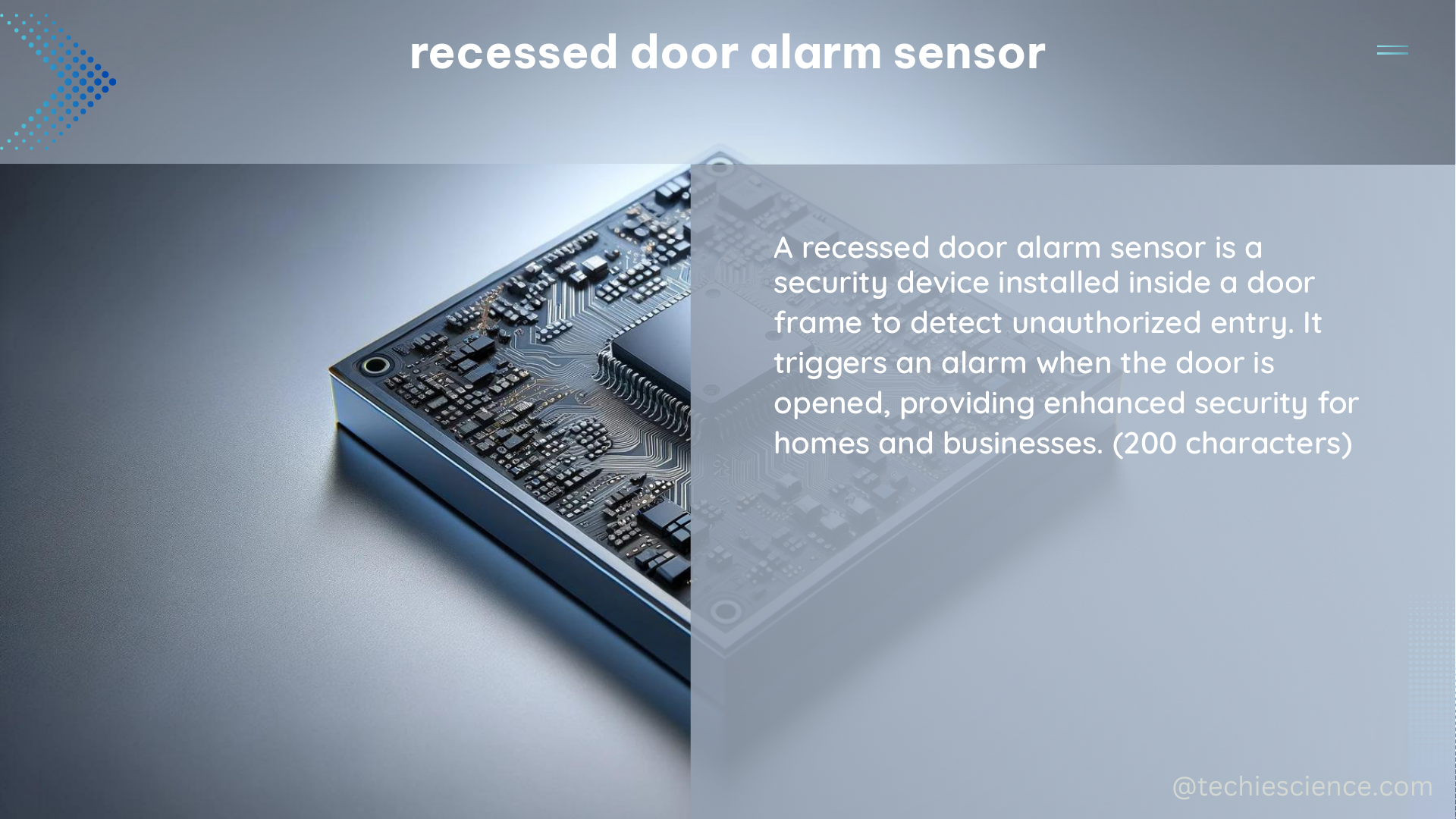Recessed door alarm sensors are a crucial component of home security systems, designed to detect any unauthorized entry through doors. These sensors consist of two main parts: the magnet and the sensor itself, working together to create a secure barrier against intruders.
Understanding the Anatomy of Recessed Door Alarm Sensors
The recessed door alarm sensor is composed of two primary elements:
- Magnet: This component is typically installed on the door itself, ensuring it is in close proximity to the sensor when the door is closed.
- Sensor: The sensor is installed on the door frame, positioned to interact with the magnet when the door is shut.
When the door is closed, the magnet and the sensor are in close proximity, completing an electrical circuit. This circuit remains intact until the door is opened, at which point the magnet moves away from the sensor, breaking the circuit and triggering the alarm.
Technical Specifications of Recessed Door Alarm Sensors

The technical specifications of recessed door alarm sensors can vary significantly depending on the manufacturer and model. Let’s explore the details of two popular options:
Sentrol 1125T “Stubby” Recessed Contacts
- Contact Gap: 0.375 inches (0.95 cm)
- Maximum Magnetic Field Strength: 3.14 gauss
- Commonly Used In: French doors and insulated doors
IQ Recessed Door Sensor (Qolsys)
- Contact Gap: 0.5 inches (1.27 cm)
- Maximum Magnetic Field Strength: 4.5 gauss
- Compatibility: Designed for use with the Qolsys IQ Panel 2 Plus security system
These specifications highlight the importance of selecting the right recessed door alarm sensor for your specific door type and security system requirements.
Proper Installation of Recessed Door Alarm Sensors
Ensuring the correct alignment of the magnet and the sensor is crucial for the proper functioning of the recessed door alarm sensor. Here are some key guidelines to follow during the installation process:
- Magnet Positioning: The magnet should be installed on the door, positioned in such a way that it is within 0.5 inches (1.27 cm) of the sensor when the door is closed.
- Sensor Placement: The sensor should be installed on the door frame, aligned with the magnet to ensure a secure connection when the door is shut.
- Precise Alignment: Some sensors, such as the Sentrol 1125T “Stubby” recessed contacts, require a more precise alignment, with a gap of 0.375 inches (0.95 cm) between the magnet and the sensor.
- Secure Fastening: Both the magnet and the sensor should be securely fastened to their respective locations to prevent any movement or misalignment.
Proper installation is crucial for the reliable operation of the recessed door alarm sensor, ensuring that it can effectively detect any unauthorized entry through the door.
Troubleshooting Recessed Door Alarm Sensor Issues
In some cases, recessed door alarm sensors may report false tamper alarms, which can be caused by various factors. To troubleshoot these issues, follow these steps:
- Inspect the Installation: Carefully examine the installation of the sensor and the magnet, ensuring that they are properly aligned and securely fastened.
- Check for Damage: Inspect the sensor and the magnet for any signs of damage, such as cracks, dents, or loose connections.
- Verify Wiring: Ensure that the wiring connecting the sensor to the security system is intact and properly connected.
- Adjust Sensor Positioning: If the issue persists, try adjusting the positioning of the sensor and the magnet to achieve the recommended gap and alignment.
- Replace the Sensor: If the problem cannot be resolved through troubleshooting, it may be necessary to replace the recessed door alarm sensor.
In the event that the troubleshooting steps do not resolve the issue, it is recommended to consult a professional security system technician for further assistance.
Conclusion
Recessed door alarm sensors are a critical component of home security systems, providing a reliable and discreet way to detect unauthorized entry through doors. By understanding the technical specifications, proper installation techniques, and troubleshooting methods, homeowners and security professionals can ensure the effective and reliable operation of these sensors, enhancing the overall security of their homes.
References
- Ideas for Placing Sensor on Recessed Door Frame
- Recessed Door Sensor Reporting Tamper
- Recessed Door Sensor Magnet Missing
- Recessed Door Sensor Magnet Missing (Additional Information)
- Recessed Door Sensor Troubleshooting

The lambdageeks.com Core SME Team is a group of experienced subject matter experts from diverse scientific and technical fields including Physics, Chemistry, Technology,Electronics & Electrical Engineering, Automotive, Mechanical Engineering. Our team collaborates to create high-quality, well-researched articles on a wide range of science and technology topics for the lambdageeks.com website.
All Our Senior SME are having more than 7 Years of experience in the respective fields . They are either Working Industry Professionals or assocaited With different Universities. Refer Our Authors Page to get to know About our Core SMEs.